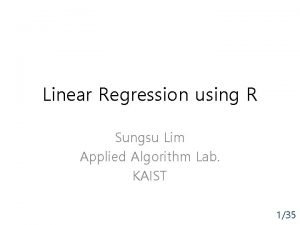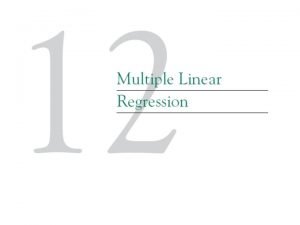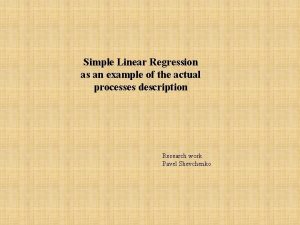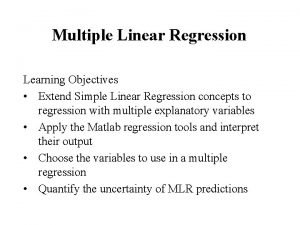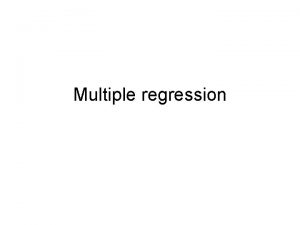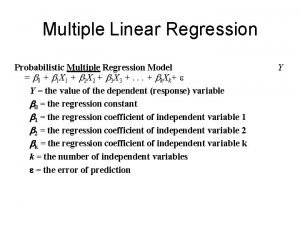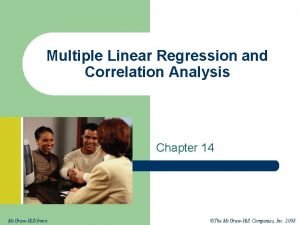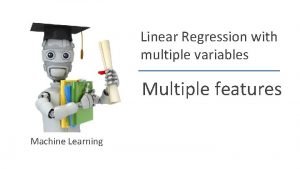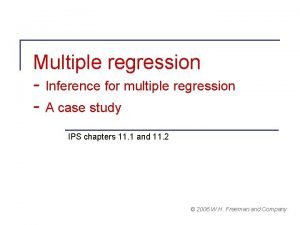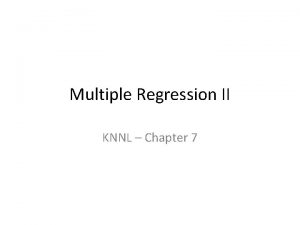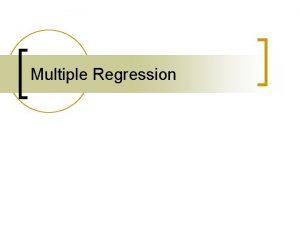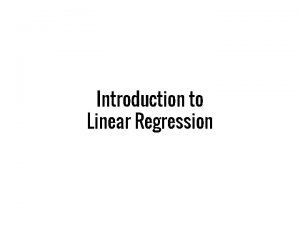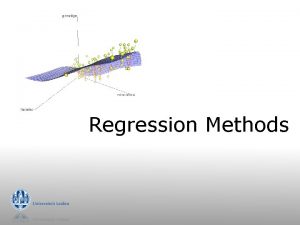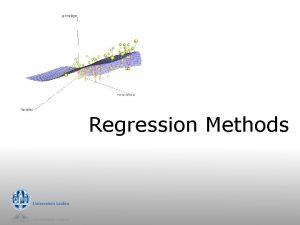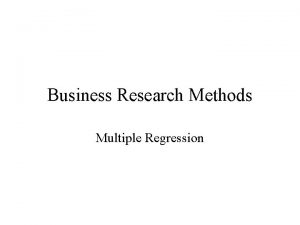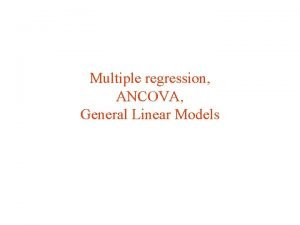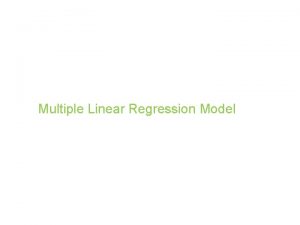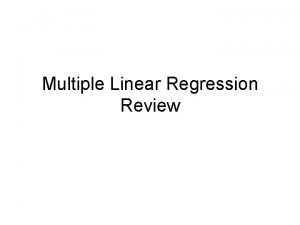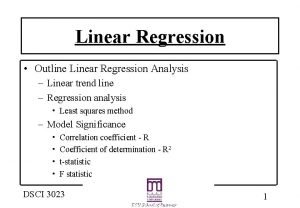Prediction of Wheat Yields Using Multiple Linear Regression


















- Slides: 18

Prediction of Wheat Yields Using Multiple Linear Regression Models in the Huaibei Plain of China Beier Zhang (AIER - China ) Qinhan Dong (VITO - Belgium)

Contents § Study area § Phenology § Trends of yields § Data sets and methods § Results of prediction § Validation § Discussions

Study area Huaibei Plain (include 6 prefectures) Area: 64154 km 2 Arable area: 20905 km 2 Main soil type : Cambosols & Vertisols Main crop type: Winter wheat & Maize

Phenology Wheat: October to next year June Sowing Emergence Tiller Wintering period Turning green Jointing Heading Maturity Harvest 10/12 10/19 12/1 12/20 2/10 3/10 4/22 5/15 6/1 Maize or soybeans: June to October

Trends of yields There are significant yearly trend of wheat yield in every prefectures from 2000 to 2011, so the trend must be considered in the prediction 8. 00 7. 00 6. 00 亳州市 Bozhou 5. 00 蚌埠市 Bengbu 4. 00 阜阳市 Fuyang 宿州市 Suzhou 3. 00 淮南市 Huainan 2. 00 淮北市 Huaibei 1. 00 0. 00 2001 2002 2003 2004 2005 2006 2007 2008 2009 2010 2011

Data sets I. Biophysical variables based on RS: using SPOT-VGT q. Ten-daily series : every dekad from 1999 to 2011 q. Variables: Smoothed k-NDVI and y-DMP q. Building data sets of RS: q. The cumulative NDVI or DMP for all possible combinations (at least 2, at most 9, because the one phenological stage is less than 3 month) of consecutive dekads within the wheat growing period (2 nd dekad of Oct to 3 rd dekad of Jun).

Data sets II. Chemical fertilizer input data sets q. Why we need this data set The reasons of the trend is the technology improvement. in our study area, chemical fertilizer input(CFI) is a most important factor of technology improvement. Chemical fertilizer input also have significant yearly trend 500000 450000 400000 350000 亳州市 300000 蚌埠市 250000 阜阳市 200000 宿州市 150000 淮南市 100000 淮北市 50000 0 2001 2002 2003 2004 2005 2006 2007 2008 2009 2010 2011 q. Variables: yearly chemical fertilizer input(1000 ton) of every prefecture, from 2000 to 2011

Data sets III. Meteorology data sets q. Variables: include rainfall, temperature and solar radiation, from 1999 to 2011 q. Interpolation method: CGMS Level-1 give us the values of every grid (25 km x 25 km) in the study area. q. Calculate average values in every prefecture q. Building data sets of Meteorology data sets: q. The average rainfall, temperature and solar radiation of every phonelogical stage of wheat in every prefecture.

Methods q. Multiple Linear Regression q. Using ΣNDVI and CFI as variables q. Using ΣDMP and CFI as variables q. Adding meteorology data as variables q. Jack-knife q. Leave-one-out (leave one year data out; regression model building using the rest of data to predict the left year; corellating the official yield with the predicted ones)

Results Regression models Using k-NDVI and CFI Prefecture Models Constant CFI ΣNDVI R 2 +5. 694*O 2 N 2+1. 934*F 2 F 3 0. 804 Absolute Error Bengbu -3. 925 Bozhou -5. 040 +0. 031*CFI +7. 376*N 1 0. 851 0. 291 Fuyang -8. 265 +0. 029*CFI +4. 255*O 2 N 1 0. 800 0. 270 Huaibei -2. 619 +0. 068*CFI +0. 702*J 2 M 3 0. 765 0. 337 Huainan -0. 422 +0. 047*CFI 0. 918 0. 261 Suzhou -1. 913 0. 653 0. 396 +11. 396*M 3 0. 299

Results Regression models Using y-DMP and CFI Prefecture Models Constant CFI ΣDMP R 2 Absolute Error Bengbu 2. 439 +0. 280*D 3 0. 736 0. 388 Bozhou 0. 468 +0. 006*A 1 Y 3+0. 114*D 3 0. 941 0. 197 Fuyang 0. 782 +0. 034*A 3 0. 786 0. 325 Huaibei -1. 365 +0. 008*A 1 Y 3+0. 016*M 2 0. 854 0. 281 Huainan -0. 422 0. 918 0. 261 Suzhou -0. 249 0. 700 0. 359 +0. 047*CFI +0. 008*M 2 Y 1

Results Regression models Using k-NDVI, CFI and Meteorology Data Prefecture Models Meteorology 0. 990 0. 062 Constant ΣNDVI Bengbu -3. 875 +6. 183*O 2 N 2 Bozhou -5. 040 +7. 376*N 1 +0. 031*CFI 0. 851 0. 291 Fuyang -12. 189 +3. 374*O 2 N 1 +0. 029*CFI +0. 282*SS 0. 907 0. 183 Huaibei -2. 588 +0. 730*J 3 M 3 +0. 071*CFI -0. 40*RJ 0. 963 0. 283 Huainan 2. 691 +0. 050*CFI -0. 053*RJ-0. 135*SH 0. 964 0. 167 Suzhou -2. 623 0. 936 0. 213 +12. 762*M 3 CFI R 2 Absolute Error -0. 019*RHV+0. 471*TJ -0. 093*RW-0. 326*SW -0. 065 RJ+0. 055*RTG

Validation Using Jack-knife method, comparing absolute error of different methods Prefecture k-NDVI &CFI y-DMP &CFI k-NDVI & CFI& Meteorology Bengbu 0. 299 0. 388 0. 062 Bozhou 0. 291 0. 197 0. 291 Fuyang 0. 270 0. 325 0. 183 Huaibei 0. 337 0. 281 0. 283 Huainan 0. 261 0. 167 Suzhou 0. 396 0. 359 0. 213 Average 0. 309 0. 302 0. 200

Validation Bengbu Huaibei Bozhou Fuyang Huainan Suzhou

Discussions n The best method n We think the method using k-NDVI & CFI& Meteorology is the best method n This method consider the fact of RS, Meteorology and technology improvement. n The average error of six prefecture in Huaibei Plain is about 0. 2 ton per ha, this is a quite good result.

Discussions n The trend of crop yield 6000 5000 4000 3000 2000 1000 0 1985 1990 1995 2000 Anhui Province 2005 2010 Morocco (Balaghi, 2008)

Discussions n Suggestion for further study n We want to use NOAA data to build a longer time sires data set (more than 20 years). n Do some field work, get the real crop yield about the field level, then build the model of this level. This work I think can adjust our method and make the result more accurately.

�� Grazie Merci Bedankt ﺷﻜﺮﺍ
 Simple and multiple linear regression
Simple and multiple linear regression Regression linear model
Regression linear model Logistic regression vs linear regression
Logistic regression vs linear regression Logistic regression vs linear regression
Logistic regression vs linear regression Multiple linear regression
Multiple linear regression Linear regression multiple features
Linear regression multiple features Sum of squares
Sum of squares Multiple linear regression variance
Multiple linear regression variance Regression equation in excel
Regression equation in excel Kr
Kr Mse econometrics
Mse econometrics Simple linear regression spss
Simple linear regression spss Regresscar
Regresscar Volue
Volue Linear regression with multiple variables machine learning
Linear regression with multiple variables machine learning Empirical bayesian kriging
Empirical bayesian kriging Perceptual linear prediction
Perceptual linear prediction Anova multiple regression
Anova multiple regression Extra sum of squares multiple regression
Extra sum of squares multiple regression






